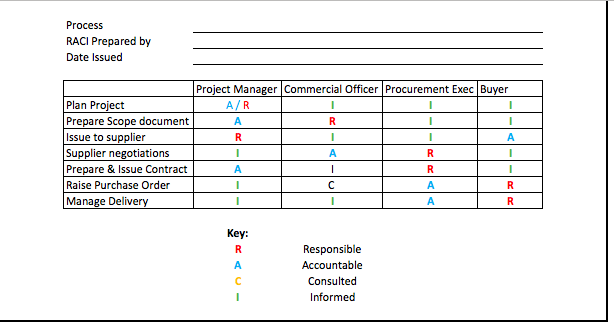As we all know process mapping can bring huge reward to your business. Not only does it provide visibility of your end to end processes and how they are executed but it can also support identifying weaknesses and improvement opportunities.
Now of course we’re blessed with tools and software packages that help simplify this process (check out our own templates on the matter here….) but the good news for those not blessed with either the inclination or the budget to buy tools is that much of this, once you have the know-how, you can do yourself.
Why RACI Matrix
One of the things I often drum into my consulting clients is that it’s not enough to know the process flow it’s vital to know who does what. My own tool for capturing who does what within a process? The RACI process map/matrix
RACI matrix are absolutely gold dust when you’re looking for things that can go wrong in a process because not only do they describe the functions at play in a given process they describe who’s doing what. They also fit nicely within the DMAIC framework of process improvement so they get you off to a good start if you’re doing the activity within a continuous improvement framework.
Let’s have a look at what a RACI Matrix looks like:
 RACI Matrix example
RACI Matrix example
As you can see it’s a mix of process steps and functional roles within that. Despite the seemingly scientific title, RACI’s are actually dead easy to use, let’s cover the basics:
RACI stands for
* Responsible – who performs/does the task
* Accountable – who is accountable for the process (whether that’s the success of it or it’s failure)
* Consulted – who collaborates and feeds back on the process
* Informed – who is informed/communicated too regarding actions and decisions relating to the process.
When things go wrong in a process it’s typically two of those actors within the process who are involved, the responsible and accountable.
The RACI matrix is just a visual presentation of the process that as well as the process steps also provides a representation of where the 4 participant types in the process get involved.
Just like any other form of process mapping there are some simple rules/principles that should be applied when producing your RACI matrix. These are:
* Like any process map focus on your imputs and outputs.
* Capture the key steps of the process in the sequence they happen.
* Correctly capture those participants involved in the process
Pro’s & Cons of RACI Matrix
For me I always recommend using a RACI model early on in process mapping / development within a company as it’s the incumbent understand who the active participants are within a business, understanding those who are the do-ers and those that are accountable if things go wrong. This offers a number of benefits:
* It helps the business understand whether the right people are accountable/responsible
* It helps identify bottlenecks where people are over-worked
* It helps identify gaps in process ownership (every process should have an owner)
* They help everyone understand thier roles within the organziation
* They help engage the workforce in process development.
But, RACI is not a cure-all and does come with it some frailties which includes:
* Whilst focusing on the process participants, the process itself can become secondary
* Who does what can still be confusing
* People new to the process might require more training than generic process mapping
* Results can sometimes be confusing
* It can become a “retrospective” tool that is used to look at what’s gone wrong historically rather than view what’s current.
How best to benefit from RACI matrix
The RACI matrix tool has itself developed and morphed into a raft of various similar permutations such as
* RACIQ – Responsible, Accountable, Consulted, Informed, Quality
* RAPID – Recommend, Agree, Perform, Input, Decide
(check out Ray Sheen’s excellent article on it here (https://www.linkedin.com/pulse/problem-raci-ray-sheen)
One of the key benefits for me is that it puts the focus of the process capture activity on resources/people. I’ve come across so many organizations where (despite efforts to the contrary), people are not connected with the processes they participate in, RACI provides a great discussion forum on which to get people to participate (it’s surprising how many different views you can obtain on who is accountable and responsible when running a workshop!!).
Finally, the use of RACI matrix can save a business significant money. RACI is an excellent staff induction tool and, in my opinion, can bring new team-members up to speed far more effectively than traditional process maps and of course the main benefit they can help facilitate continuous improvement significantly.
Have some views on the RACI matrix? We’d love to hear from you in our comments section below.